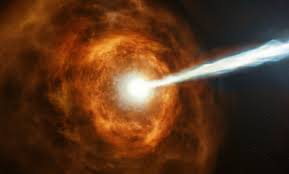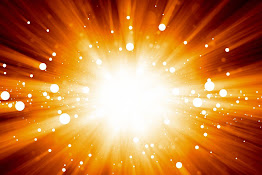7 reason for that earth can be destroyed.
Earth is only planet in our solar system, has the life. But we are the most intelligent animal. We are making pollution a lot and that's why life on earth are at risk. But do you know even earth is floating on space with very uncertainty. Any time it will be set in danger. Hi, today i am going to discuss about the most 7 reason for that earth can be destroyed. so let's go and enjoy it.
1. The Earth's molten core might cool.

Earth is surrounded by a protective magnetic shield, called the magnetosphere. Let us know the reason of creation of such magnetic shield. Earth’s magnetic field is caused by a dynamo effect. The effect works in the same way as a dynamo light on a bicycle. Magnets in the dynamo start spinning when the bicycle is pedaled, creating an electric current. The electricity is then used to turn on the light.
This process also works in reverse. If you have a rotating electric current, it will create a magnetic field. On Earth, flowing of liquid metal (iron and nickel) in the outer core of the planet generates electric currents. The rotation of Earth on its axis causes these electric currents to form a magnetic field which extends around the planet.
The magnetic field is extremely important to sustaining life on Earth. It protect us from the high amount of radiation radiated by sun. The magnetosphere deflects energetic particles that emanate from the sun, changing its size and shape as it's hit. The resulting flood of high-energy particles that slam into Earth's air can trigger beautiful auroras, or sometimes disruptive geomagnetic storms.
If and when the core cools, the dynamo shuts off and we lose our magnetosphere — along with protection from solar winds. This would slowly blast our atmosphere into space.
This is likely what happened to the atmosphere on Mars— once rich with water and a thick atmosphere — suffered this same fate billions of years ago. As Mars doesn’t have flowing liquid metal in its core, it doesn’t produce the same dynamo effect. This left the planet with a very weak magnetic field, allowing for its atmosphere to be stripped away by solar winds, leaving it uninhabitable and also Mars leading to the nearly airless, possibly lifeless world we know today.
2. The sun can start to die and expand.
The sun, and our position relative to it, is perhaps the most important piece of our tenuous existence. But the sun is still a star. And all stars die.That won't last forever, though. The Sun survives by burning hydrogen atoms into helium atoms in its core. In fact, it burns through 600 million tons of hydrogen every second. And as the Sun’s core becomes saturated with this helium, it shrinks, causing nuclear fusion reactions to speed up - which means that the Sun spits out more energy.
Billions of years from now the sun will run low on hydrogen and start fusing helium. t's a more energetic reaction. Almost 3.5 billion years from today, the Sun will shine almost 40 percent brighter, which will boil Earth’s oceans, melt its ice caps, and strip all of the moisture from its atmosphere. Our planet, once bursting with life, will become unbearably hot, dry, and barren - like Venus.
On the other hand, when the burning of hydrogen will stop, the star will formally leave the main sequence and may be considered as a red giant. When the Sun becomes a full blown red giant, its core will get extremely hot and dense while its outer layer expands ... a lot. as well as it's mass will decrease.
So then our earth will has two option - either will be consumed by sun or will escape from sun's gravitational pull. In first case you understand well what will happen. But in second case earth's temperature will decrease gradually and finally become a frozen rock.
3) Speaking of rogue planets: One can shove Earth into a deadly orbit.
The first question is that what is rogue planets? A rogue planet is a planetary-mass object that does not orbit a star directly. Such objects have been ejected from the planetary system in which they formed or have never been gravitationally bound to any star or brown dwarf. The Milky Way alone may have billions of rogue planets.
one of those rogue planets can drift into the solar system, by using it's huge gravity, put Earth into an extreme and inhospitable orbit, or even kick us out of the solar system. It will make all planet's orbit including earth more elliptical. That's why It will bring us much closer to the Sun for very short and exceptionally hot summers. But after that The Earth might be thrown in the next ice age. Instead of global warming, we shall be worried about global cooling. We have to rethink our energy sources, and try to pump out more greenhouse gases to warm the planet up a little.
on one word it will become hard or very uncomfortable for life to survive. That's almost right till now but if the rogue planet will kick us out of the solar system, what will happen?
When this situation will come our planet will become a rogue planet.As a rogue planet, Earth would freeze into an ice ball. So all life will finish at that time.
Instead of just passing by Earth and disrupting its orbit, a drifting world can make direct hit. It will not be novel. About 4.5 billion years ago, a small planet crashed into a larger planet in the solar system — forming Earth and its moon..
A new theory suggests the two planets completely vaporized into a rapidly spinning doughnut of gaseous and liquid rock. Over time, the moon and Earth condensed from the chaotic cloud. So i'm sure you understand it properly what will happen.
4. Asteroids and comets could bombard the planet.
Rocks from space can be pretty destructive. Asteroids are large, rocky bodies that orbit the Sun. They range from a few to hundreds of metres in diameter. Near about 66 million years ago a big one probably wiped out the dinosaurs — though it would take a lot of asteroids to properly dispatch the entire planet. Still, it could happen. Earth was heavily bombarded by asteroids for hundreds of millions of years after it formed. The impacts were so intense that the oceans boiled for a full year. All life was single-celled at that point, and only the most heat-tolerant microbes made it. Today's larger lifeforms almost certainly wouldn't make it. Air temperatures could reach more than 900 degrees Fahrenheit for several weeks. So if any asteroid will collide with our planet may be we have to face same phase.
5. The Earth can pass too close to a wandering black hole.
They are as mysterious as they are frightening. Even the name is ominous. We don't know much about them, but we know they're so dense that not even light can escape beyond a black hole's event horizon. And scientists think "recoiled" black holes are wandering through space, just like rogue planets. It's out of thinking that one can pass through the solar system.
A small black hole might harmlessly pass through the Earth, though anything larger than mass of the moon — and the size of a grain of sand — will cause big problems.
If light can't escape, the Earth definitely won't. There are two ideas about what could happen after the point of no return, given a big-enough rogue black hole. Beyond the event horizon, atoms might stretch until they're pulled apart entirely: a process called the noodle effect.
Other physicists have theorized we'd run right into the end of the universe, or end up in an entirely different one. Even if a recoiled black hole misses Earth, it might pass closely enough to cause earthquakes and other devastation, kick us out of the solar system, or spiral us into the sun.
6) The Earth can be destroyed in a gamma ray burst.
Gamma ray bursts, or GRBs, are one of the most powerful phenomena in the universe. Most are the result of massive stars collapsing when they die. One short blast can emit more energy than our sun will over the course of its lifetime. That energy has the potential to remove the ozone layer, flood the Earth with dangerous ultraviolet light, and trigger rapid global cooling.
In fact, a GRB pointed at Earth might have caused the first mass extinction 440 million years ago.Luckily, David Thompson, deputy project director on the Fermi Gamma-ray Space Telescope, told National Geographic that GRBs aren't really a big concern.
7. The universe can go to pieces in its final "Big Rip."
This is the thing that could actually end the whole universe, not just the Earth.The idea: A mysterious force called dark energy is pushing the universe apart at a faster and faster rate. If this keeps accelerating, as it seems to be doing now, perhaps 22 billion years from now the force that keeps atoms together will fail — and all matter in the universe will dissolve into radiation.
But assuming the "Big Rip" is a dud, who knows what might happen after a global calamity humans don't survive?
It's possible some microbes and fungi will survive to reseed more complex life. But if our destruction is total, we could at least hope some other intelligent life exists out there, and can pay its respects.







